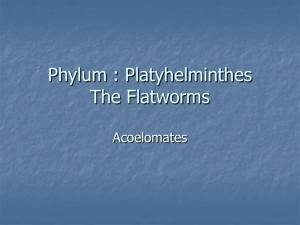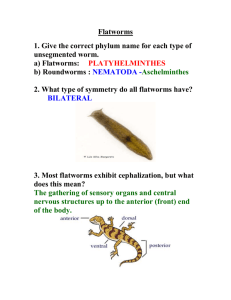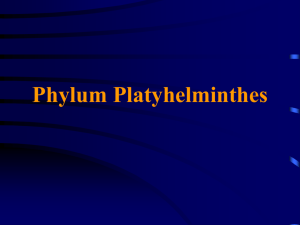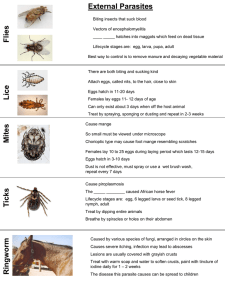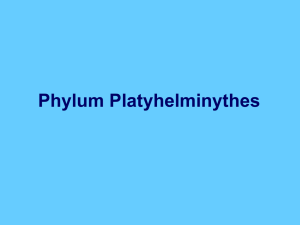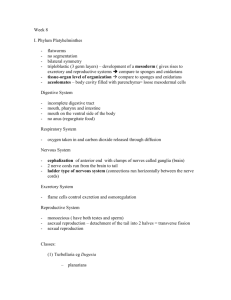PHYLUM PLATYHELMINTHES
advertisement
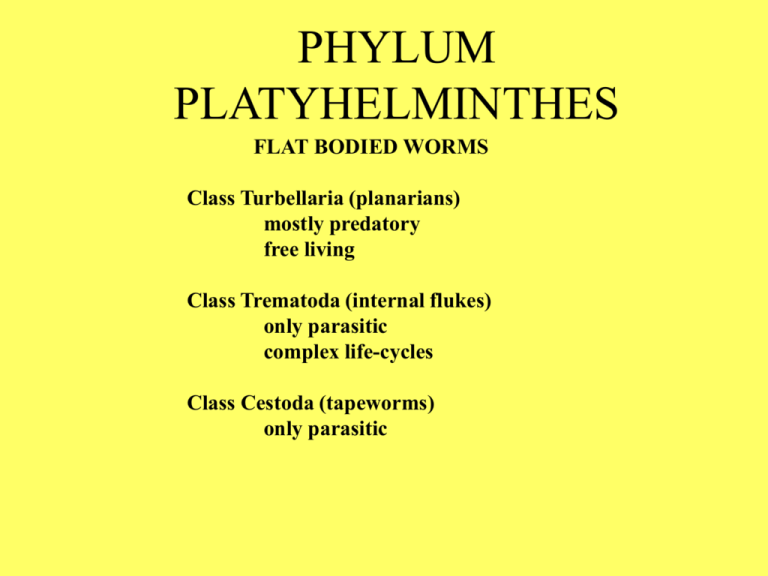
PHYLUM PLATYHELMINTHES FLAT BODIED WORMS Class Turbellaria (planarians) mostly predatory free living Class Trematoda (internal flukes) only parasitic complex life-cycles Class Cestoda (tapeworms) only parasitic EXAMPLES • PLANARIA – FREE LIVING – AQUATIC AND TERRESTRIAL – Herbivore, carnivore, scavenger • TAPEWORMS – INTESTINAL PARASITE W/ MORE THAN 1 HOST TAENIA • FLUKES – INTERNAL PARASITE W/MORE THAN ONE HOST – BLOOD FLUKE SCHISTOSOMA – LIVER FLUKE FASCIOLA TRAITS • ORGAN LEVEL OF ORGANIZATION • BILATERAL SYMMETRY • SAC TYPE BODY – 1 OPENING/ no anus – GASTROVASCULAR CAVITY IS BRANCHED • TRIPLOBLASTIC – 3 GERM/tissue LAYERS • CEPHALIZATION – has a head • BRAIN WITH 2 NERVE CORDS & TRANSVERSE NERVES • SENSE ORGANS – light and chemicals – Occeli/eyespots and auricles/ears TRAITS • ACOELOMATE – no coelom/body cavity • DIFFUSION METHODS FOR: – – – – GAS EXCHANGE - O2 and CO2 WASTE REMOVAL – by FLAME CELLS CIRCULATION of nutrients and waste REMEMBER: DIFFUSION IS A SLOW PROCESS; HI TO LO Epidermis/ ECTODERM gut cavity Lining of gut =ENDODERM Acoelomate organism (flatworm) no body cavity; region between gut and body wall packed with organs within MESODERM tissue TRAITS • MUSCLES FOR LOCOMOTION • REPRODUCTION – ASEXUAL – REGENERATE – SEXUAL – HERMAPHRODITES BUT CROSS FERTILIZE EVOLUTIONARY MILESTONE • ORGAN LEVEL OF ORGANIZATION – reproductive, excretory, muscular • BILATERAL SYMMETRY • CEPHALIZATION – Anterior and posterior – Dorsal and ventral Platyhelminthes Taxonomy Classes of Phylum Platyhelminthes • • • • --Widely distributed in N. America -- about 200 species --Occur in both lakes and streams -- Stream-dwelling species more differentiated than lake species • --Species diversity increases in temperate areas 20 to 60 species per lake Class Turbellaria • Free-living flatworms; mostly marine •microscopic to two feet Locomotion in Turbellaria •move by means of cilia and mucous • •2 layers of muscle; longitudinal and circular •Stimulated by nervous system • contractions for turning, twisting and folding of the body Nutrition in Turbellaria •carnivores and predators of other animals or dead remains. •muscular pharynx is inserted into prey •Secretes digestive enzymes •Fragments are pumped into mouth on ventral surface •Further digestion in gastrovascular cavity •branching increases the surface area for digestion and absorption •No anus, only mouth; •Undigested food excreted from mouth and pharynx as in cnidaria •GVC aids both digestion and circulation – distributes nutrients and oxygen to tissues Sensory/nervous Brain/ganglia • • • • • nerve cords Exhibits cephalization Group of nerve tissue (GANGLIA) at anterior Ganglia attached to 2 nerve chords well developed sensory eyespots for light auricles for chemical and mechanical (touch) receptors Reproduction in Turbellaria Asexual--•By fission or dividing •Regeneration of missing parts Sexual•hermaphrodites w/ cross-fertilization •Internal fertilization •Zygote released to water testis ovary penis genital pore oviduct EXCRETION IN TURBELLARIA Excretory pore pharynx (protruded) protonephridia Flame cells flame cell nucleus cilia •Cilia of flame cells remove excess water and nitrogen wastes of body •Waste moves to tubules •Exits out pores in head •Needs excretory system as tissues become thicker and more cells present opening of tubule at body surface flame cell fluid filters through membrane folds Excretory tubules Class Trematoda – the Flukes COMMON EXAMPLE OF COMPLEX LIFE CYCLE Class Trematoda •live as parasites • protected from digestion by protein coat •2 suckers: 1. Oral sucker attaches to organs of the host 2. Ventral sucker or acetabulum attaches to host tissues Types of Hosts •Complex life cycles •Alternate between sexual and asexual stages • Most require at least 2 different kinds of hosts to complete their life cycle 1. Definitive host (primary host) • where parasite matures and reproduces (sexually) •host in which eggs are released 2. Intermediate host • Hosts in which larval stages develop and undergo asexual reproduction • Results in an increase in the number of the individuals Schistosoma •a common blood fluke of SE Asia •causes shistosomiasis •Definitive host = humans •Intermediate host = snails • In humans - eggs penetrate and damage intestinal and bladder tissue •constant inflammation and eventual deterioration of liver, spleen and other organs General Life Cycle - Chinese liver fluke, Clonorchis sinensis • Adults live in the bile ducts of humans, dogs, and cats • There are 2 intermediate hosts: a snail and a fish • Eggs are passed out of the definitive host and hatch as ciliated larvae called miracidia • The miracidia penetrates a snail molluscan host and becomes a sporocyst • They undergo asexual reproduction producing larvae called rediae • Rediae often asexually produce more rediae, but will eventually give rise to larvae called cercariae • They leave the molluscan host and penetrate fish • They encyst in the fish tissues as the metacercaria • Consumption of infected fish results in the metacercaria excysting in the gut and migrating to the bile duct Class Cestoda •Protective protein coat •anterior region is called a scolex; •often armed with suckers and hooks • Extending from neck of scolex is a series of proglottids; •contain sex organs and eggs; •no digestive system • Mature eggs released through an opening in the proglottid •leave the host when the proglottids break off b A definitive host eats infected, undercooked beef a Larvae become encysted in intermediate host tissues c Scolex of larva attaches to intestine’s wall d Many proglottids form by budding f Cattle may ingest embryonated eggs or ripe proglottids to become intermediate hosts e Ripe proglottids containing fertilized eggs leave host in feces Beef Tapeworm, Taeniarhynchus saginatus • Definitive host = humans; •intermediate host = cattle • Eggs are shed with human feces; •infected persons defecate in a pasture or untreated sewage • eggs are ingested by cattle • Eggs hatch •larvae bore into intestinal wall •get into the circulatory system •transported to muscle • If uncooked beef is consumed the larvae is freed •scolex develops, forming the adult • Symptoms include loss of weight, chronic indigestion, diarrhea

